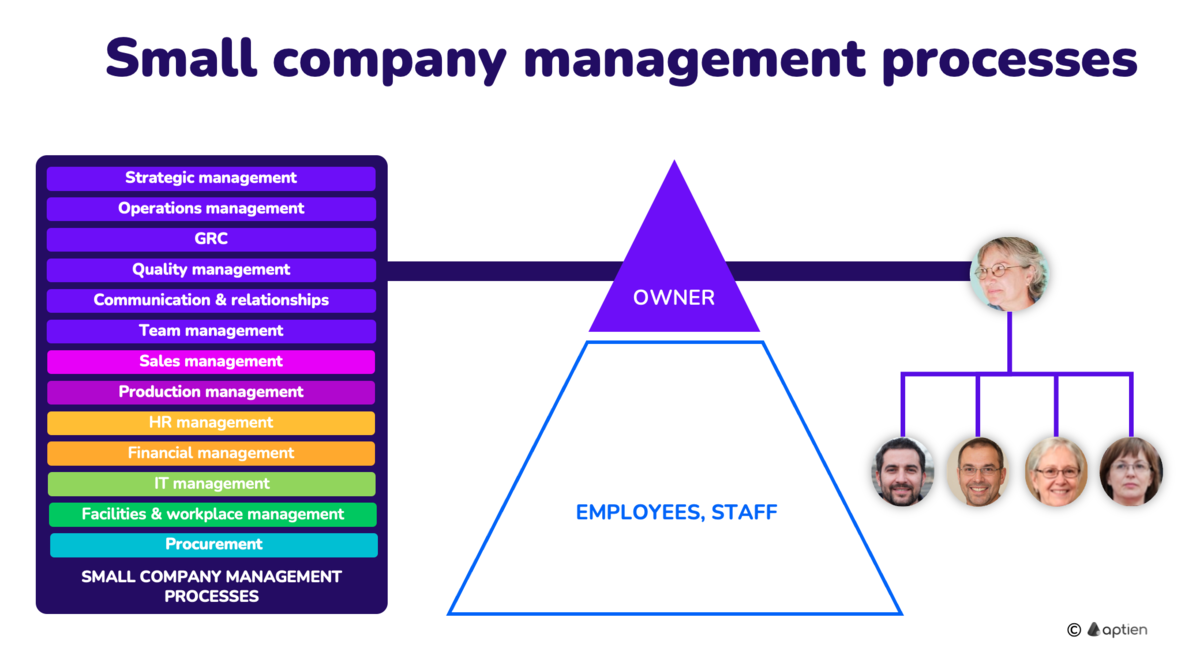Managing small companies is different from managing large companies. Due to the number of people and overall size, the management structure is much simpler. Unlike large companies, small and medium-sized businesses have only one or two management levels. Middle management is absent and management takes place on just two levels. Small companies often manage with only a single level of management.
Small company as a "Family business" (up to approx. 10-15 people)
- The company is usually run by one person (often the owner acting as manager). They know everyone personally, oversee every project and decide on details.
- Owner/Manager: Often the business owner who oversees all aspects of the business.
- Management is therefore often at a single level
- Communication and processes are informal, based on verbal agreements or customs
First managerial breakpoint for a small company (approx. 20-25 people)
- Introducing middle management becomes necessary and is a turning point for managing and organizing work.
- The founder can no longer effectively manage all 20-25 people at once.
- There is a need for team leaders, project managers or senior specialists who take on part of the daily management and communication.
- Communication: Regular team meetings and formal communication channels (e.g. intranet) are required.
- Company data management: Not everything can remain in emails and spreadsheets; the need for systems grows.
- Emphasis on processes: Informal processes start to fail. You find it necessary to formalize:
- Change in people management: The focus shifts from direct control to management through a "middle layer". The founder focuses more on strategy.
Second managerial breakpoint: transition to a medium-sized company (approx. 25-70 people)
- At this point the company already needs a formal HR department, even if it is just one person.
- At this size the company becomes a mid-size business, including changes to organizational structure
- It becomes necessary to start managing the company by rules and a clear structure, like a mid-size business
How Aptien helps manage small businesses
- Simple job and task management – they don't have a project department, but need an overview of who is doing what.
- Tasks and reminders: managing work with tasks → trackers for reviews, contract expirations, service dates.
- Asset and equipment records – who has a laptop, phone, car, keys.
- Contracts and document management – customer contracts, leases, service agreements so nothing "falls through the cracks".
- Basic HR and personnel administration – employment contracts, vacations, occasional training, with onboarding still informal.
- Cost control – a simple overview to prevent money from "leaking".
- Minimal administration – they don't want complex systems or an ERP, and don't need an accounting module.
- Simple records for jobs, contracts, assets, employees (an easy replacement for Excel).
- Cost tracking → simple cost tables let you monitor project, training, and maintenance expenses without a large ERP.
With Aptien you get what small businesses need
- All-in-one instead of Excel and email – clarity without the chaos.
- Easy to use, quick to implement solution, no complex rollout required.
- Customizable records: as simple as adding tabs in Excel – you can easily build your own "organizer" as needed (something not naturally offered by Trello or Smartsheet).
